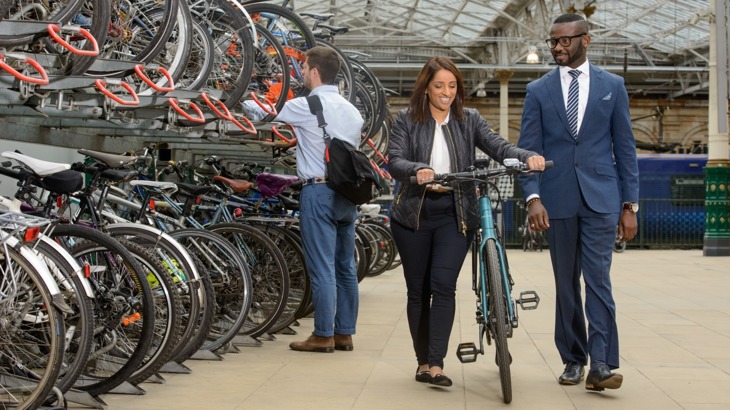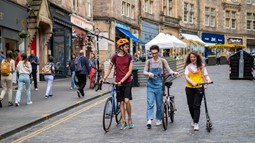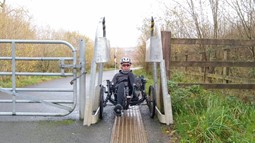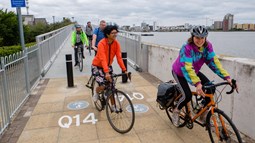Making it easier for people to access public transport by foot or by cycle is essential to enabling people to reduce their reliance on the private car, as well as alleviating congestion in our urban centres and around principal public transport stations.

Summary
- Public transport is vital for enabling people to access work, education, everyday amenities, and friends. This is especially true for the many people who do not have access to a car. Growth in public transport is critical for achieving net-zero and growing the economy.
- Active travel and public transport go hand in hand – almost all public transport journeys include a walk, wheel or cycle to or from the stop or station. This means better public transport will encourage more active travel, and vice versa.
- Many local bus routes have been cut or reduced in length across the UK and train reliability in parts of the UK is poor.
- Public transport needs investment to ensure journeys are affordable, inclusive, frequent, reliable, and integrated. Public transport should also be better integrated with walking, wheeling and cycling.
- People should have access to a public transport stop or station with a regular and affordable service within a reasonable distance of their home, or 400m in urban areas. Stops and stations should be accessible, safe and attractive for people walking, wheeling and cycling.
Context
Transport is the largest source of greenhouse gas emissions in the UK, with cars and taxis contributing the majority of these emissions [1].
There are also significant health benefits including for air quality and physical activity by shifting away from private vehicles to more sustainable and active modes of transport.
Many people across the UK do not have access to a car. Access is lower among people of colour, disabled people, people on low household incomes and young people [2]. This leads to greater use of and reliance on public transport by these groups. People in households without access to a car make five times more bus trips than those with access [3].
Yet, during 2022, one in ten bus routes in Great Britain were cut [4] and new analysis suggests up to half of local registered bus routes in England have been cut since 2010 [5]. Scotland has lost 41 million kilometres of bus routes in five years [6] with Wales and Northern Ireland also facing cuts.
Train reliability is worsening across the UK. Annual cancellation scores have been increasing year on year since 2014, reaching a peak of 3.8% of trains cancelled in the 2022-23 financial year [7]. Whilst punctuality of trains has not improved over the same period, with no evidence to suggest significant improvements are coming [8].
Active travel is key to accessing public transport, and use of public transport often precipitates people engaging in active travel. Therefore, improving, maintaining and integrating active travel with public transport is mutually beneficial to the uptake of both methods of transportation. This is especially important as public transport continues to recover from the pandemic, especially for bus use which far outstrips rail use in passenger numbers but is still down on pre-pandemic figures.
In Germany 91% of public transport users walk to their stop [9]. Recent figures are not available for the UK, however there is a clear, documented link between active travel and public transport [10].
Since UK Government guidance in 1973, 400m has been recognised as the maximum recommended walking distance people should live from a bus stop [11,12,13,14].
What Sustrans thinks
Long-term dedicated investment in public transport
Active travel is a great way to reduce emissions and help people access things locally.
However, in order to achieve our net-zero targets we also need to reduce more medium and longer journeys by private motor vehicle.
Evidence clearly shows we cannot rely on the electrification of private vehicles alone [15].
Even if Government targets for all new cars to be electric by 2035 are met, we will still need to help people to reduce car use and switch to more sustainable options [16].
Coupled with this, electric cars still create particulate air pollution and cause congestion.
Investing in active travel and public transport while fully integrating these modes is critical for net-zero and reducing transport inequality for households who do not have access to a car or are struggling to afford one.
These investments will also have the additional benefits of improving public health and wellbeing, as well as having a positive economic impact.
Pausing new road projects, which act to induce demand for vehicle use, would unlock long-term funding for sustainable modes including walking, cycling, and public transport.
Affordable and convenient public transport journeys, especially by bus, are key to encouraging modal change for longer distances, especially when integrated with walking, wheeling, and cycling.
Affordable public transport
Public transport needs to be affordable for everyone. We welcome initiatives to reduce costs including the Young Persons’ Free Bus Travel Scheme in Scotland, the six-month suspension of peak fares by ScotRail, and the temporary fare cap for buses in England.
However, in the context of over a decade of fare rises outstripping wage increases on both bus and rail there are limitations [17].
The cost of travelling by bus and coach has increased significantly more, by proportion, than that of motoring expenditure over the last four decades, with rising costs putting people off using public transport [18].
Across the UK between July 2013 and December 2022 the cost of living increased by 44%, while motoring costs rose by 38%. At the same time bus travel increased by 83%.
Despite the temporary fare cap in England, introduced in January 2023, UK bus costs are still rising higher than the cost of living and motoring [19].
Meanwhile, fuel duty has been frozen for the last 13 years and was cut in 2022, resulting in it being 37% lower in real terms than in 2010. CO2 emissions as a result are 7% higher than they would have been without the freeze [20].
The UK Government is continuing to act to invest more in making car and rail use cheaper than bus use despite these modes typically being used by people on higher income levels and ignoring the needs of people on a low income or not in employment.
In England, 41% of people said the £2 fare cap would help them to travel more, with early reports suggesting that the fare cap has increased bus usage [21,22].
The cap should be made permanent and similar schemes should exist across all parts of the UK, whilst further pricing reductions or free travel should be made available to disadvantaged groups.
Improved service levels and coverage
The UK Government and devolved governments should empower local transport authorities to take greater control of buses, including setting routes and minimum service levels, including for frequency and reliability.
Public transport needs to be frequent, reliable, and integrated across modes and providers to make it an attractive option for users.
Turn-up and go options, where services are frequent enough that you don’t need a timetable, are common in London but should be present across all urban and suburban areas, alongside demand-responsive transport options in more rural areas.
Services should run at the times people require, including early mornings and late evenings, and do so without frequent or substantial delays that deter people from using the service.
Infrastructure that supports this, such as bus gates and bus lanes, would help to prioritise buses and make them more competitive with private vehicle use.
Local transport authorities should also be enabled to develop single ticketing systems integrated across all operators and modes, with price caps for usage comparable to the leading authorities in England.
Ferries, cycle and e-scooter share schemes should be incorporated as part of an integrated ticket offer.
Proximity to public transport
We support the concept of 20-minute neighbourhoods, as a way to give people choice over how they travel and increase walking, wheeling, cycling, and public transport use within and beyond neighbourhoods.
Local planning authorities across the UK need to choose the right locations for new developments that can unlock opportunities for better quality public transport.
Building within and alongside existing urban areas acts to increase housing density, helping to make public transport financially sustainable.
Public transport stops also need to be accessible.
We support the recommendation for all new homes to be within 400m walking or wheeling distance of a bus stop, tram stop or a railway station with a regular and affordable service [23].
Improved walking and wheeling access to and within public transport stops and stations.
Public transport stations and stops should be fully accessible for all users.
Routes around public transport hubs should be clearly signposted and easy to navigate by passengers, including disabled passengers.
They should utilise walking and wheeling, and cycling infrastructure that is already in place and supplement it where needed, to improve accessibility.
Walking and wheeling to stops and stations should also be inclusive.
The Disabled Citizens’ Inquiry showed we need to improve accessibility for walking and wheeling including calling for greater investment in pavements and improved crossing points [24].
We support Network Rail’s Access for All program, installing accessibility improvements at various stations across the network [25].
We would like to see these improvements implemented more consistently to further aid disabled people to be able to make their journeys safely. For example, tactile surfaces at the top of all staircases and platform edges, and lifts with audible tones to provide step-free access at all stations.
Stations should be safe and attractive places to arrive at.
Having pedestrianised areas around stations and interchanges would improve pedestrian safety and security, making accessing them by walking and wheeling a more attractive option.
Where usage levels make it viable, stations should be staffed to provide assistance and improve safety for all passengers.
Where permanent staffing is not feasible alternative measures need to be put in place to ensure timely help can be provided at all stations when needed, including staff on trains.
Women should not have to feel scared when using public transport [26] and disabled people should have the same right to travel independently as anyone else does.
Additionally, making stations accessible from different approaches can open them up to more users. Leeds station, for example, opened an additional entrance on the south side, encouraging walking from people in the south of the city and relieving congestion at the north side entrance [27].
Bus stops, especially in rural areas, where they are often the only form of public transport, need to be easily accessible by walking and wheeling.
Stops should provide adequate seating and shelter to ensure they are accessible to and safe for all people to use.
They should be linked up with the surrounding communities and be located close to essential local amenities. Increased use of on-demand bus services across the UK would also be beneficial.
Better provision for cycling to, from and on railways
The use of cycles alongside public transport significantly increases the range of destinations that are accessible without relying on private vehicles. However, many people are put off cycling because of safety concerns and the practicalities of travelling with a cycle.
Introducing physically separated cycle lanes on main roads, reducing traffic levels on neighbourhood streets and lowering speed limits can all help improve perceptions of safety. Whilst cycle storage, both at stations and on public transport, can help to overcome some of the practical issues.
All users should be entitled to secure, weather-protected cycle storage at all train stations and bus interchanges, including for adapted cycles and tandems.
Providing convenient, secure and free cycle parking at Ashford International Station, for example, has seen the number of cycles parked at the station on weekdays more than triple [28].
The provision of free cycle storage on trains is one of its current strengths. However, the disparity of provision between operators and their different methods for booking cycle spaces can lead to confusion for passengers and rail staff.
We would like to see turn-up-and-go services or at the very least a single, standardised system for cycle bookings to simplify the process and advocate for cycle spaces to be clearly marked on the outside of trains to help streamline journeys.
Cycle storage on all new trains needs to be as flexible as possible to meet the needs of a diverse population. For example, flip down seats that accommodate commuters during peak times, and prams and cycles off peak.
As the number of people with e-bikes increases, more needs to be done to regulate battery use to minimise fire safety concerns.
Cycle provision on buses and trams is more limited than on trains. Cycle storage facilities, whilst not practical at all bus stops, should be considered particularly in areas where fewer stops serve more dispersed populations.
Cycle and e-scooter share schemes should link up with public transport interchanges and key bus and tram stops.
This will allow for more integrated journeys to be made by more people. It is particularly beneficial to people who cannot afford their own cycle, or do not have provision to store one at home.
What we’re doing
We’re working with the Department for Transport and the Train Operating Companies through the Cycle Rail Working Group, and their equivalents throughout the UK on ways to improve cycle rail facilities, including bikes on trains and station parking.
In Scotland, we are working with ScotRail to increase cycle capacity across its routes and introduce dedicated cycle carriages on trains to the tourist hot spots of the West Highlands.
We’re calling for improved cycle provision to be a franchise requirement.
It is essential that the design of future rolling stock includes provision for cycles to be carried more easily.
[1] GOV.UK, 2021. Transport and environment statistics: Autumn 2021.
[2] GOV.UK, 2022. National Travel Survey 2021: Household car availability and trends in car trips.
[3] GOV.UK, Annual Bus Statistics: year ending March 2022 (revised).
[4] The Guardian, 2022. Almost one in 10 local bus services axed.
[5] The Independent, 2023. Map bus routes cut.
[6] BBC Reporting Scotland, 2023.
[7] Office of Rail and Road, Passenger rail performance January to March 2023, (pdf).
[8] Office of Rail and Road, Table 3138 - Train punctuality at recorded station stops by operator (periodic).
[10] Kollektiv Forum, 2023. Public transport users are pedestrians:
[11] Department of Environment Circular 82/73 (DOE, 1973) gives 400 metres as the recommended maximum walking distance along the footpath system.
[12] Transport Scotland, 2018. Transport and Travel in Scotland Results from the Scottish Household Survey.
[13] London.gov, 2021. Planning Bus Services (3).
[14] Active Travel England, 2023, Active Travel England Standing Advice Note: Active travel and sustainable development.
[15] Climate Change Committee, 2023. 2023 Progress Report to Parliament.
[16] Energy Digital, 2022. EVs alone ‘won’t get us to net zero’.
[17,18,19] RAC Foundation, 2023. Transport price index.
[20] Carbon Brief, 2023. Analysis: Fuel-duty freezes have increased UK CO2 emissions by up to 7%.
[21] GOV.UK, 2023. £2 fare cap evaluation: Interim report 2023.
[22] Intelligent Transport, 2023, UK passengers embrace £2 bus fare cap, choosing bus travel over cars.
[23] Active Travel England, 2023, Active Travel England Standing Advice Note: Active travel and sustainable development.
[24] Sustrans, 2023. Disabled Citizens’ Inquiry.
[25] Network Rail, 2020. Access for All – Improving accessibility at railway stations nationwide.
[26] The Independent, 2022. Nearly half of all women feel unsafe using public transport. tion, 2016. Leeds Station Southern Entrance.
[28] GOV.UK, 2020. Encouraging cycle journeys to rail stations.





